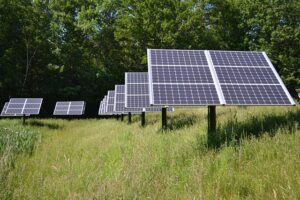
The Need for Sustainable Energy Solutions
In today’s world, finding sustainable energy solutions is not just a goal—it’s a necessity. As the effects of climate change become more apparent, the transition to clean, renewable energy sources is more urgent than ever. This transition, however, comes with its own set of challenges, particularly in managing the intermittent nature of renewable energy sources like wind and solar power. This is where energy storage comes into play, revolutionizing the way we generate, store, and use energy.
Role of Energy Storage in the Energy Transition
Energy storage is the linchpin that can transform the renewable energy landscape. It allows us to capture energy when it’s abundant and store it for when it’s needed. Imagine being able to harness the sun’s power during the day and use it to light up our homes at night or to store excess wind energy on a blustery day to keep our appliances running smoothly when the air is still. This capability not only enhances the reliability of renewable energy but also makes it a more viable and efficient option.
Overview of the Energy Storage Revolution
The energy storage revolution is driven by rapid advancements in technology, increasing investments, and a growing recognition of its critical role in sustainable energy systems. From cutting-edge battery technologies to innovative mechanical and thermal storage solutions, the field is evolving at a breathtaking pace. This article will delve into the different types of energy storage systems, the benefits and challenges they present, and the future prospects that they hold.
Understanding Energy Storage
What is Energy Storage?
Energy storage involves capturing energy produced at one time for use at a later time. This process can take various forms, from batteries that store electrical energy to thermal systems that store heat or cold. The primary goal is to balance supply and demand, ensuring that energy is available whenever it’s needed, regardless of when it was produced.
Historical Background of Energy Storage
The concept of energy storage is not new. Early examples include the use of dams to store water for hydroelectric power generation. However, it wasn’t until the development of modern battery technologies and other advanced storage methods that energy storage became a key component of our energy infrastructure.
How Energy Storage Works
Energy storage systems work by converting energy from one form to another for storage and then converting it back when needed. For example, batteries convert electrical energy into chemical energy during charging and convert it back to electrical energy during discharge. Mechanical storage systems like pumped hydro use gravitational potential energy, while thermal storage systems store heat energy.
Types of Energy Storage Systems
Battery Storage
Lithium-Ion Batteries
Lithium-ion batteries are the most common type of battery storage used today. Known for their high energy density and efficiency, they are used in everything from smartphones to electric vehicles and large-scale energy storage projects.
Solid-State Batteries
Solid-state batteries represent the next generation of battery technology. They use a solid electrolyte instead of a liquid one, which makes them safer and potentially more efficient. These batteries are still in the development stage but hold great promise for the future of energy storage.
Mechanical Storage
Pumped Hydro Storage
Pumped hydro storage is one of the oldest and most established forms of energy storage. It involves pumping water uphill to a reservoir during times of low energy demand and releasing it to generate electricity when demand is high.
Flywheel Energy Storage
Flywheel energy storage systems store energy in the form of rotational kinetic energy. These systems are highly efficient and can quickly release large amounts of energy, making them ideal for stabilizing power grids.
Thermal Storage
Molten Salt Storage
Molten salt storage systems are used primarily in conjunction with solar power plants. These systems store thermal energy in molten salts, which can retain heat for extended periods and release it to generate steam and electricity when needed.
Ice Energy Storage
Ice energy storage involves freezing water to create ice during off-peak times and using the ice for cooling during peak demand periods. This method is particularly useful for reducing the energy load on air conditioning systems.
Chemical Storage
Hydrogen Storage
Hydrogen storage involves converting electrical energy into hydrogen through electrolysis. The hydrogen can then be stored and later used in fuel cells to generate electricity. This method offers a way to store large amounts of energy for long periods.
Power-to-Gas Systems
Power-to-gas systems convert surplus renewable energy into synthetic gas, such as hydrogen or methane. This gas can be stored and used to generate electricity or for other energy needs, providing a versatile storage solution.
Advancements in Battery Technology
Improvements in Lithium-Ion Batteries
Recent advancements in lithium-ion batteries have focused on increasing energy density, reducing costs, and enhancing safety. These improvements have made lithium-ion batteries the go-to choice for a wide range of applications, from consumer electronics to grid-scale energy storage.
Emergence of Solid-State Batteries
Solid-state batteries are emerging as a game-changer in the energy storage field. They offer higher energy densities, longer lifespans, and improved safety compared to traditional lithium-ion batteries. As research progresses, these batteries are expected to revolutionize the storage industry.
Role of Advanced Materials
The development of advanced materials, such as silicon anodes and solid electrolytes, is driving significant improvements in battery performance. These materials offer higher capacities and better stability, paving the way for more efficient and durable energy storage solutions.
Benefits of Energy Storage
Enhancing Grid Stability
Energy storage plays a crucial role in enhancing grid stability. By providing a buffer between energy supply and demand, storage systems can smooth out fluctuations and ensure a reliable and consistent power supply.
Facilitating Renewable Energy Integration
One of the biggest challenges with renewable energy sources is their intermittency. Energy storage helps mitigate this issue by storing excess energy produced during periods of high generation and releasing it when generation is low, facilitating the integration of renewables into the grid.
Reducing Energy Costs
Energy storage can help reduce energy costs by shifting consumption from peak to off-peak periods. This not only lowers electricity bills for consumers but also reduces the need for expensive peaking power plants, benefiting the overall economy.
Providing Energy Security
In times of emergencies or natural disasters, energy storage systems can provide critical backup power. This ensures that essential services remain operational and enhances overall energy security.
Challenges and Limitations
High Initial Costs
One of the main challenges of energy storage is the high initial cost of installing and deploying storage systems. While costs are decreasing as technology advances, the upfront investment can still be a barrier for many.
Technical and Engineering Challenges
Developing efficient and reliable energy storage systems involves overcoming significant technical and engineering challenges. These include improving energy density, enhancing battery lifespans, and ensuring safety and reliability.
Environmental and Safety Concerns
Energy storage systems, particularly batteries, pose environmental and safety concerns. Issues such as the sourcing of raw materials, recycling of used batteries, and potential for fires or explosions need to be addressed.
Regulatory and Market Barriers
The regulatory landscape for energy storage is still evolving. Market barriers, such as lack of standardization and clear policies, can hinder the deployment and integration of storage systems.
Innovations Driving the Energy Storage Revolution
Breakthroughs in Battery Chemistry
Breakthroughs in battery chemistry, such as the development of lithium-sulfur and solid-state batteries, are driving the energy storage revolution. These advancements offer higher energy densities, longer lifespans, and improved safety.
Development of New Storage Technologies
Beyond batteries, new storage technologies are emerging. These include advanced flywheels, compressed air energy storage, and thermal storage solutions, which offer diverse and innovative ways to store energy.
Integration with Smart Grids and IoT
The integration of energy storage with smart grids and the Internet of Things (IoT) is enhancing the efficiency and reliability of energy systems. Smart grids can optimize the use of stored energy, while IoT devices provide real-time data for better management and control.
Energy Storage and Climate Change
Reducing Carbon Emissions
Energy storage can play a significant role in reducing carbon emissions by enabling the widespread adoption of renewable energy sources. By storing excess energy and releasing it when needed, storage systems help replace fossil fuel-based power plants.
Supporting Renewable Energy Adoption
The ability to store and dispatch renewable energy on demand is critical for increasing its adoption. Energy storage systems ensure that renewable energy can be relied upon to meet energy needs, even when the sun isn’t shining or the wind isn’t blowing.
Long-Term Sustainability
Investing in energy storage contributes to long-term sustainability by providing a reliable and renewable energy source. As technology continues to advance, storage systems will become more efficient and accessible, supporting a sustainable energy future.
Global Leaders in Energy Storage
United States
The United States is at the forefront of the energy storage revolution, with significant investments in research and development. The country is home to numerous large-scale storage projects and continues to lead in innovation.
China
China has rapidly become a global leader in energy storage, driven by its ambitious renewable energy goals. The country is investing heavily in battery manufacturing and storage technologies, positioning itself as a key player in the market.
Germany
Germany’s commitment to renewable energy has made it a leader in energy storage as well. The country is focused on integrating storage systems with its extensive wind and solar power infrastructure to ensure a stable and reliable energy supply.
Australia
Australia is emerging as a leader in energy storage, particularly in the deployment of large-scale battery systems. The country’s vast renewable energy resources and remote locations make energy storage a critical component of its energy strategy.
Case Studies of Successful Energy Storage Projects
Hornsdale Power Reserve (Australia)
The Hornsdale Power Reserve in South Australia, powered by Tesla’s battery technology, is one of the largest and most successful energy storage projects in the world. It has proven to be highly effective in stabilizing the grid and reducing energy costs.
Tesla’s Megapack Projects (Global)
Tesla’s Megapack projects, deployed worldwide, are setting new standards for large-scale energy storage. These projects demonstrate the potential of battery storage to provide reliable and cost-effective energy solutions.
Siemens Gamesa’s Hybrid Energy Storage System (Spain)
Siemens Gamesa’s hybrid energy storage system in Spain combines wind, solar, and battery storage to create a flexible and efficient energy solution. This project showcases the benefits of integrating multiple renewable energy sources with advanced storage technology.
Economic Impact of Energy Storage
Job Creation and Economic Opportunities
The development and operation of energy storage projects create numerous jobs, from construction and engineering to maintenance and research. These projects can stimulate local economies and provide long-term employment opportunities.
Investment and Funding in Energy Storage
Investment in energy storage is growing, with both public and private sectors recognizing its potential. Government incentives, grants, and partnerships with private companies are driving the development of new storage projects.
Long-Term Financial Benefits
Despite the high initial costs, energy storage offers long-term financial benefits. The low operating and maintenance costs, combined with the predictability and reliability of stored energy, make it a financially viable option in the long run.
Environmental and Social Considerations
Sustainable Sourcing of Materials
Sustainable sourcing of materials for energy storage systems is crucial for minimizing environmental impact. This includes using recycled materials and ensuring ethical supply chains for raw materials like lithium and cobalt.
Community Engagement and Support
Engaging with local communities and addressing their concerns is vital for the success of energy storage projects. Transparent communication, fair compensation, and community involvement can foster support and cooperation.
Contributions to Sustainable Development Goals
Energy storage aligns with the United Nations Sustainable Development Goals (SDGs), particularly those related to affordable and clean energy, climate action, and sustainable cities and communities. By investing in energy storage, we can contribute to global sustainability efforts.
Future Prospects of Energy Storage
Emerging Trends in Energy Storage
Emerging trends in energy storage include the development of floating batteries, advanced energy management systems, and the integration of artificial intelligence for optimized operation and maintenance. These innovations are driving the future of energy storage.
Potential for Expansion
The potential for energy storage expansion is significant, with many untapped locations around the world. Advancements in technology and engineering are opening new possibilities for storage deployment and integration.
Vision for a Sustainable Energy Future
The vision for a sustainable energy future involves a world where clean, renewable energy from various sources is stored and used efficiently to power our homes, businesses, and industries. By continuing to innovate and invest in energy storage, we can move closer to this vision.
Integration with Other Technologies
Combining Energy Storage with Renewable Energy
Combining energy storage with renewable energy sources like wind and solar can create a more resilient and balanced energy system. Hybrid projects that utilize multiple renewable sources can optimize energy production and enhance grid stability.
Enhancing Energy Efficiency
Energy storage can enhance overall energy efficiency by reducing energy waste and improving the management of energy supply and demand. This leads to more sustainable and cost-effective energy systems.
Role of Artificial Intelligence and Big Data
The integration of artificial intelligence (AI) and big data with energy storage systems is transforming the energy landscape. AI can optimize storage operations, predict maintenance needs, and improve energy management, while big data provides valuable insights for decision-making.
Public Perception and Education
Raising Awareness about Energy Storage
Raising public awareness about the benefits and potential of energy storage is crucial for gaining support and investment. Educational campaigns, community events, and media coverage can help inform and engage the public.
Addressing Public Concerns
Addressing public concerns about energy storage, such as environmental impacts and costs, is essential for building trust and support. Transparent communication and evidence-based information can help alleviate these concerns.
Promoting Community Involvement
Promoting community involvement in energy storage projects can enhance their success. Involving local communities in the planning and development process can lead to better decision-making and increased support for the projects.
Conclusion
Recap of Energy Storage Benefits
Energy storage offers numerous benefits, including enhancing grid stability, facilitating renewable energy integration, reducing energy costs, and providing energy security. It is a reliable and sustainable solution to our energy needs.
The Path Forward for Energy Storage
The path forward for energy storage involves embracing new technologies, integrating with other renewable sources, and prioritizing environmental and social considerations. By doing so, we can unleash the full potential of energy storage.
Final Thoughts
As we look to the future, it’s clear that energy storage will play a crucial role in our global energy landscape. By balancing innovation with sustainability, we can create a cleaner, greener, and more resilient energy system for generations to come.




